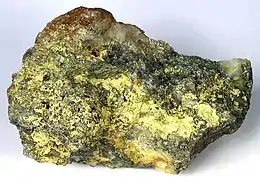Molybdite
Molybdite is the naturally occurring mineral form of molybdenum trioxide MoO3. It occurs as yellow to greenish needles and crystallizes in the orthorhombic crystal system.
| Molybdite | |
|---|---|
 Molybdite on molybdenite from the Questa Molybdenum Mine (size: 11.0 x 6.7 x 4.1 cm) | |
| General | |
| Category | Mineral |
| Formula (repeating unit) | MoO3 |
| IMA symbol | Myb[1] |
| Strunz classification | 4.EA.10 |
| Crystal system | Orthorhombic |
| Crystal class | Dipyramidal (mmm) H-M symbol: (2/m 2/m 2/m) |
| Space group | Pbnm |
| Unit cell | a = 3.96 Å, b = 13.85 Å, c = 3.69 Å; Z = 4 |
| Identification | |
| Color | Light greenish yellow to nearly colorless |
| Crystal habit | Flattened needles or thin plates may occur in aggregates |
| Cleavage | Perfect on {100}, district on {001} |
| Tenacity | Flexible |
| Mohs scale hardness | 3 - 4 |
| Luster | Adamantine |
| Streak | White |
| Diaphaneity | Transparent |
| Specific gravity | 4.72 |
| Optical properties | Biaxial (+) |
| Birefringence | High |
| 2V angle | Large |
| References | [2][3][4][5] |
Discovery and occurrence
Molybdite was first described in 1854 for and occurrence in quartz veins in the Knöttel area of Krupka, Ore Mountains, Bohemia (today in the Ústí nad Labem Region of the Czech Republic.[4] It occurs in vein cavities and as coatings in molybdenite ore veins and quartz topaz greisens. Associated minerals include molybdenite, betpakdalite and quartz.[3] The similar mineral ferrimolybdite is often misidentified as molybdite.[3]
References
- Warr, L.N. (2021). "IMA–CNMNC approved mineral symbols". Mineralogical Magazine. 85 (3): 291–320. Bibcode:2021MinM...85..291W. doi:10.1180/mgm.2021.43. S2CID 235729616.
- "Molybdite". Mineral Atlas (database record). Retrieved 2023-01-15.
- Molybdite on the Handbook of Mineralogy
- "Molybdite". www.mindat.org. Hudson Institute of Mineralogy. Retrieved 2023-01-15.
- "Molybdite Mineral Data". www.webmineral.com. Retrieved 2023-01-15.
This article is issued from Wikipedia. The text is licensed under Creative Commons - Attribution - Sharealike. Additional terms may apply for the media files.